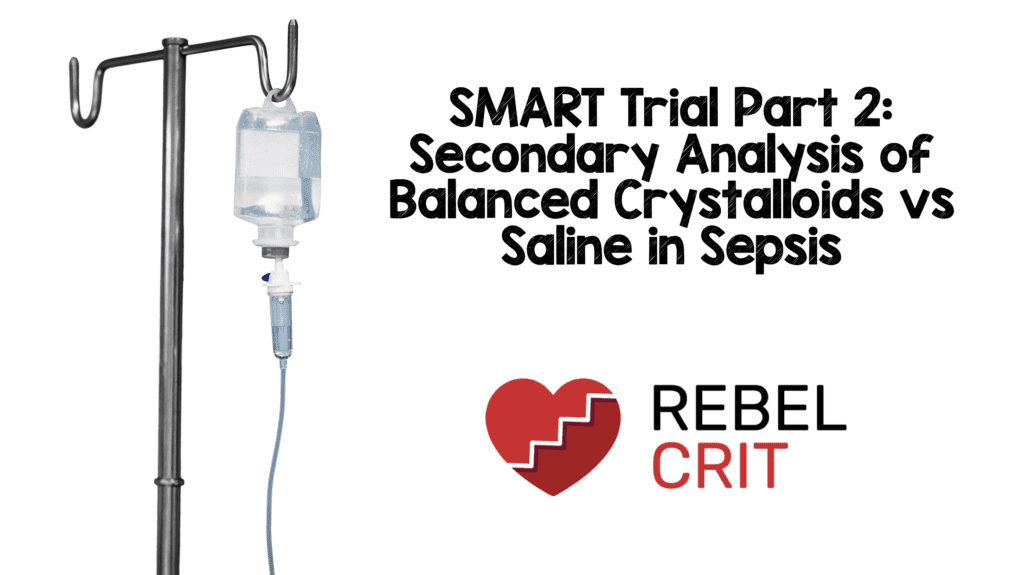

What They Did:
- Compare the effect of balanced crystalloids versus saline on 30d in-hospital mortality among critically ill adults with sepsis
- Secondary analysis of patients from the Isotonic Solutions and Major Adverse Renal Events Trial (SMART) admitted to the medical ICU with a diagnosis of sepsis
- The SMART trial was a non-blinded, cluster-randomized, multiple-crossover trial among critically ill adults admitted to 5 ICUs at Vanderbilt University
- Patients enrolled received either the clinician’s choice of lactated Ringer’s solution or Plasma-Lyte A vs saline (0.9% sodium chloride) for intravenous fluid
Outcomes:
- Primary: 30d in-hospital mortality
- Secondary:
- 60d in-hospital mortality
- ICU-free days
- Ventilator-free days
- Vasopressor-free days
- Renal replacement therapy-free days
- Proportion of patients with major adverse kidney events within 30d (MAKE30) – Defined as death, new receipt of RRT or persistent renal dysfunction at the 30d
Inclusion:
- Adult patients
- Diagnosis of sepsis
- Admitted to medical ICU
Exclusion:
- Age <18 years
- Transferred from outside hospitals
Results:
- Of 15,802 patients enrolled in SMART trial, 1641 (10.4%) patients were admitted to the medical ICU with a diagnosis of sepsis
- Cumulative Volume Through Day 3
- NS = 1935 +/- 2873mL
- BC = 1872 +/- 2744mL
- Median Volume Administered
- BC = 1000mL (Range 0 – 3210)
- NS = 1020mL (Range 0 – 3500)
- 30d In-Hospital Mortality:
- Balanced Crystalloids: 26.3%
- Saline: 31.2%
- aOR 0.74; 95% CI 0.59 – 0.93; p = 0.01
- NNT = 20
- Major Adverse Kidney Events Within 30d (MAKE30):
- Balanced Crystalloids: 35.4%
- Saline: 40.1%
- aOR 0.78; 95% CI 0.63 – 0.97
- Vasopressor-Free Days
- Balanced Crystalloids: 20 +/- 12
- Saline: 19 +/-13
- aOR 1.25; 95% CI 1.02 – 1.54
- Renal Replacement Therapy-Free Days:
- Balanced Crystalloids: 20 +/- 12
- Saline: 19 +/- 13
- aOR 1.35; 95% CI 1.08 – 1.69
Strengths:
- Used mortality as the primary outcome which is a patient oriented outcome
- Prespecified subgroup analysis
- Baseline characteristics were well balanced between groups
- Confirmed the result of the primary outcome with numerous sensitivity analyses
Limitations:
- Secondary analysis of a larger clinical trial making the results at risk of a type I error
- All patients were enrolled from a single academic center
- Fluid randomization was not blinded
- Primary analysis was based on ICD-10 codes as a surrogate for sepsis
- Differences in ventilator-, vasopressor-, and renal replacement therapy-free days are sensitive to differences in in-hospital mortality between groups
- Also look at limitations of the SMART trial as they apply here
Discussion:
- 91% of patients in the balanced crystalloid group received lactated Ringer’s solution, essentially making this a LR vs NS comparison. We cannot extrapolate these results to other balanced crystalloids such as Plasma-Lyte A
- Serum Electrolyte Levels by Solution
- Volume of Fluid After ICU Admission
- Composition of Study Fluids
Author Conclusion: “Among patients with sepsis in a large randomized trial, use of balanced crystalloids was associated with a lower 30-day in-hospital mortality compared to use of saline.”
Clinical Take Home Point: We have stated before on the blog that it makes more physiological sense to use balanced crystalloids in large volume (>2L) resuscitation, and given the weight of evidence if you are using NS or a balanced crystalloid as your resuscitation fluid of choice keep using your fluid of choice. It appears now in this secondary analysis of the SMART trial there appears to be a lower 30d in-hospital mortality with the use of lactated Ringer’s solution vs saline which pushes the needle even further to support use of balanced crystalloids over saline in patients with sepsis.
References:
- Brown RM et al. Balanced Crystalloids Versus Saline in Sepsis: A Secondary Analysis of the SMART Trial. Am J Respir Crit Care Med 2019. PMID: 31454263
- Semler MW et al. Balanced Crystalloids Versus Saline in Critically Ill Adults. NEJM 2018. PMID: 29485925
For More Thoughts on This Topic Checkout:
Post Peer Reviewed By: Anand Swaminathan, MD (Twitter: @EMSwami)
The post SMART Trial Part 2: Secondary Analysis of Balanced Crystalloids vs Saline in Sepsis appeared first on REBEL EM - Emergency Medicine Blog.
